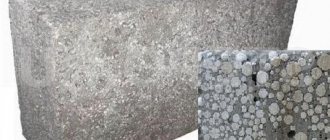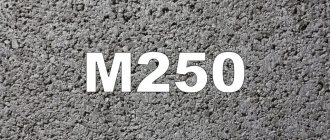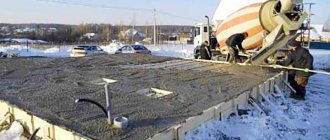Quite often, when making various compositions or mixtures, professional craftsmen use components in the form of salt, which should give it additional qualities. At the same time, various disputes constantly arise about whether this should be done and in what proportions. Therefore, the question of why salt is added to concrete and how much is needed to achieve the desired result is of great concern to novice specialists.
Amateur photo of the consequences in the form of stains from rusting reinforcement and sedimentation on the surface when using salt in a concrete solution
Salt in concrete or antifreeze additives for construction
At low temperatures, the hardening process of cement mixtures slows down significantly.
This is due to the fact that the water included in the building mass crystallizes under such conditions, interfering with the normal hydration process. For fresh concrete, such a situation is disastrous and has a very very bad effect on the strength of the structure being created. The process of crystallization of water from frost in a fresh solution leads to the fact that it becomes loose and is endowed with low frost-resistant properties. The physics of this process is simple and understandable even to schoolchildren. As water freezes, it expands, which breaks the bond between the cement and the aggregate.
What are the requirements for the solution?
There are several basic requirements for masonry mortar that it must meet.
- The solution should fill all the voids and cavities that exist in the brick structure. To achieve this goal, it is necessary that the prepared solution be sufficiently plastic.
It is important that the solution remains viscous for a long time
The solution must also have good adhesion
Preparation of cement mortar
GOST 28013-98. Construction solutions. General technical conditions. Downloadable file (click the link to open the PDF in a new window).
SP 82-101-98. Preparation and use of construction mortars. Downloadable file (click the link to open the PDF in a new window).
Antifreeze additives
Monolithic structures created in warm weather, after drying, are durable and high-quality structures.
Note! The greater strength of reinforced concrete products means that if it is necessary to create a hole in a given structure or shorten it, it is necessary to use methods such as cutting reinforced concrete with diamond wheels and diamond drilling of holes in concrete.
But in order to ensure the same level of strength for cement structures created in winter, it is necessary to use measures that allow water to be retained in the building mass in a liquid state.
Antifreeze additives, which are also called concrete setting and hardening accelerators, can help in this matter. They make it possible to reduce the freezing point of the liquid, thereby helping to normalize the hardening process of the cement monolith structure.
Types of antifreeze additives
Means for this type on the modern market are presented in two main types:
- Compositions that interfere with the crystallization processes of liquids in building mixtures by lowering the freezing point of the building mass. They are also called retarders or mild cement set accelerators. These substances include two types of electrolytes:
- Strong - table or technical salt for concrete (sodium chloride), sodium nitride;
- not strong - ammonia solution, substances of limited origin (urea, polyhydric alcohols);
- Antifreeze compounds that help accelerate the hardening process and have high antifreeze properties. Such additives include potash, mixtures based on calcium chloride with sodium nitrite, with sodium chloride, etc.
Sodium chloride in the fight against frost
NaCl – sodium chloride (CN) or simple commercial salt. Concrete with technical salt is an excellent substance for construction work in winter at subzero temperatures.
Main characteristics of CN
Technical salt is added to the cement mortar to give it anti-frost properties.
This additive has the following properties and features:
Note! This component for concrete is the most inexpensive antifreeze additive.
- NaCl does not affect the rate of hardening of the solution; therefore, winter concrete with salt may have been mixed long before it was poured. Thus, mixing the building mass with this additive can be done, for example, at the factory long before its transportation to the construction site without loss of fundamental properties;
- Such an additive increases the mobility of solution particles, which facilitates the process of forming products of the desired shape from a given mass;
- It does not change the structure of the cement mass.
Advice. It is recommended to use calcium chloride together with sodium chloride.
The availability of this type of antifreeze additive and its low price is usually the reason that most builders resort to the use of completely different, more expensive means.
In addition to the many advantages of such an additive, it also has one significant drawback, which usually makes it unfeasible to use for concrete. The fact is that salt has a high level of corrosive activity.
And this shows that the use of metal reinforcement at the same time as a cement mixture with the addition of sodium chloride will lead to the process of rusting and peeling of this structure from the concrete.
Thus, the reinforced concrete structure loses its integrity, which significantly reduces the strength level of the entire product.
The process of adding salt to a solution
The instructions stipulating the proportions of salt in the cement mortar are based on the average daily temperature and expected strength:
- The average daily ambient temperature from 0 to -5 degrees suggests the addition of CN in the amount of 2% of the total mass of the mixture. The expected strength of the structure when dried in frost for 7 days will be 30%, 28 days - 80% and 90 days - 100%;
- The average daily ambient temperature from -6 to -15 degrees suggests the addition of CN in the amount of 4% of the total mass of the mixture. The expected strength of the structure when dried in frost for 7 days will be 15%, 28 days - 35% and 90 days - 50%.
Advice. The proportions of salt in concrete also require the addition of calcium chloride in the first case in the amount of 0.5% by weight of the solution, and in the second 2%.
Liquid soap or dishwashing detergent
Do you want to increase the plasticity of the mixture by making the solution mobile and pliable? Ordinary liquid soap copes with this task perfectly, improving the quality of concrete and simplifying work with it. This recipe is useful if you need to get a high-quality mixture for plastering walls and carrying out interior work.
Working with cement really takes a lot of effort. The increased viscosity of the solution affects this, and adding water does not save the situation, but only aggravates it, making the solution excessively liquid and ineffective. A small amount of liquid soap helps correct the situation. The concrete turns out to be more “obedient”, easier to mix and apply.
This effect occurs due to the enveloping of particles that make up the concrete. A slimy film forms between them, but at the same time they do not lose adhesion, providing excellent strength. As for the proportions of liquid soap, it is recommended to add no more than 5% of the total mass of the prepared solution.
Advantages and disadvantages
In order to resolve this dispute, it is necessary to consider all the advantages and disadvantages of this method and draw a conclusion based on them. At the same time, the question of how much salt to add to concrete should be answered only if the research result is positive.
The consequences of using salt as an additive during winter installation affect not only the appearance, but also the strength
The need to use salt
It is generally accepted that if you add salt to concrete, it receives additional characteristics that allow it not to be covered with water in the cold, which means that work can be done in winter at sub-zero temperatures.
Also, some craftsmen claim that thanks to such delivery, the rate of hardening increases, since this substance draws out moisture.
It is worth remembering that concrete is also susceptible to corrosion, and a salty environment only accelerates this process.
- It is worth noting that no specialist can give an exact answer to the question of how much salt to add to concrete. The fact is that some builders believe that this depends on the total volume of the solution, while other craftsmen claim that the percentage is commensurate with the temperature outside.
- It is also necessary to say that the question of how much salt to add to concrete in winter is asked by people who have delayed repairs or have incorrectly allocated time for a particular process. If professionals plan to build in cold weather, they do not use additives, but additional heating systems and temperature-appropriate mixtures.
- It is very important to say that adding salt to concrete to give it special qualities is a kind of myth. The fact is that there is practically no benefit from this, since according to those who use it, the temperature should not be less than 7 degrees.
Advice! It is much easier to purchase ready-made concrete from a company that makes hot mixtures with a high pour point. However, you need to work with such a composition very quickly so that it does not set.
There are many other, more effective ways to heat the solution
Flaws
First of all, it should be noted that material with added salt can be sawed with regular wheels. You will no longer need to cut reinforced concrete with diamond wheels, since the hardened product will be less durable, which will also affect its service life.
It is worth noting that a salty environment has a negative effect on fittings. Therefore, if we add salt to concrete with metal inclusions, we must remember that it will almost immediately begin to cause corrosion and weaken the entire structure over time.
Also, such a technical solution will begin to produce visual effects over time. The salt will come to the surface in the form of a white sediment, which looks very unsightly.
Considering the seriousness of these shortcomings, professionals do not recommend using this method. At the same time, the question of how much salt should be added to concrete naturally remains unanswered.
Advice! Using warm formwork or artificial heating of concrete is much more practical, although it leads to additional costs.
Some antifreeze additives also significantly improve the strength of the finished product.
Other Supplements
It is worth noting that the obsessive desire to do the work with your own hands and at sub-zero temperatures sometimes does not justify the costs at all. However, if the budget is small, then you can use special additives for concrete, which are sold on the building materials markets.
These materials allow you to work even at temperatures of minus 17, although this depends on the brand of the product chosen. At the same time, the strength of the solution does not decrease at all and diamond drilling of holes in concrete will again become relevant.
Antifreeze additives do not contain salt, but are environmentally friendly
Some craftsmen believe that such mixtures are not environmentally friendly. However, their instructions usually state the opposite, since such additives contain only natural ingredients.
Among the main advantages of such compositions is their cost-effectiveness. The fact is that their price and consumption are very low, especially compared to other heating options.
This mineral negatively affects concrete buildings and all its positive qualities do not justify the side effects
Conclusion
By watching the video in this article, you can get additional information about this concreting method. Also, taking as a basis the article proposed above, it should be concluded that salt is not the most successful additive for working in the cold season.
Salt in concrete and mortar: why and how much?
Of course, you can use special polymer-based additives that will prevent the water in the solution from freezing in the cold. But all this significantly increases the cost of the mixture. Previously, the construction magazine samastroyka.ru already talked about “folk” additives to concrete and mortar. The use of salt was also mentioned there, but only very superficially. This article will tell you why salt is added to cement mortar or concrete, as well as its specific proportions of use.
Fluffy (lime)
Ordinary slaked lime is also excellent for increasing the consumer properties of concrete mortar. This recipe comes from the Soviet era, and at that time, as you know, they built to last. It has a beneficial effect on the quality of concrete, making the solution more elastic and sticky. When using lime, working with concrete becomes easier and more enjoyable.
Here it is important to draw the readers’ attention to another useful feature of slaked lime - its bactericidal properties. By adding it to concrete, you will get a mixture that is resistant to fungi and mold. This recipe is recommended for use in cases where it is necessary to carry out work in rooms with high dampness.
Why is salt added to concrete?
Adding salt to concrete and cement mortar makes it possible to carry out construction work at subzero ambient temperatures. It takes about a few days for the cement mortar to harden, but in cold weather, this period is significantly reduced. Because of this, the building mixture is destroyed from the inside, it becomes loose and fragile.
Salt added to the cement mortar prevents the water from freezing for some time in the cold, which has a positive effect on the quality of the mortar. However, the opinions of builders regarding the addition of salt to concrete and cement-based mortars are seriously divided.
Some of them believe that when salt is added to concrete, the corrosion of metal reinforcement elements increases sharply. Other builders, on the contrary, add salt to the solution and consider this additive to be the cheapest of all antifreeze additives. Salt allows the use of cement-based solutions at negative air temperatures.
Be that as it may, each additive to concrete and cement mortar should be used at your own peril and risk. In this case, you should definitely know its correct proportions in relation to the volume of the building mixture. Otherwise, you can only make things worse.
How much salt should be added to concrete and cement mortar?
The amount of salt in cement mortar or concrete depends entirely on the ambient temperature. Salt is added to concrete and cement mortars only if they have to be worked with at subzero temperatures, when it is necessary to prevent the rapid freezing of water and their destruction as a result.
So, for example, at air temperatures from 0 to - 5 degrees, the percentage of salt in the total mass of the building mixture should be approximately 2%. At temperatures from -5 to -15 degrees, salt is added to the cement mortar at least 4% of its total mass.
In addition, taking into account the high corrosion processes when adding salt to concrete, one main nuance can be highlighted: salt can be used as an anti-frost additive only for those concrete structures that do not have metal reinforcement elements. For example, when pouring concrete onto a blind area where reinforcement is not used. With this approach, salt, as an antifreeze additive, will be the cheapest option.
However, according to the same experts, it is better to completely abandon the use of concrete and cement mortars at subzero temperatures. It is advisable to plan concrete work so that it does not take place during the winter. In any case, both the strength and durability of building structures using concrete and cement mixtures built at this time will be much lower.
Question. Hello! In a private conversation with a neighbor who was building an extension to his house, I learned that he was adding kitchen salt to cement. True, the neighbor refused to answer the question of why he was doing this. Tell me why he does this and in general, does salt corrode cement and what effect does it have on the solution itself?
Answer. Good afternoon I want to reassure you right away - table (commercial) salt (chemical formula NaCl (sodium chloride) does not corrode cement. This is one of the most accessible and inexpensive antifreeze additives that ensures the continuity of concrete work in low temperatures.
The physical essence of adding table salt to cement (concrete) is to lower the freezing point of the mixer (water). As you know from high school physics, salt water has a lower freezing point. The freezing point of water depends on the salt concentration. The result of such an operation is as follows. Even at sub-zero temperatures, the curing agent is in a liquid state. This allows the cement to undergo the stages of hydration, setting and hardening to the required value without additional heating costs.
Advantages of NaCl as an antifreeze additive
- Lowest price among other analogues;
- Does not affect the setting speed of concrete or mortar. This allows you to prepare the material long before it is transported to the site and poured;
- Table salt increases the mobility of the solution, which in turn increases its workability.
NaCl addition proportions depending on expected ambient temperature
- The expected air temperature at the concrete work site is 0-5 degrees Celsius. The amount of salt added to concrete solutions is 2% of the total weight of the mixture. In this case, the strength of the concrete structure will be: 30% of the brand strength for 7 days, 80% of the brand strength for 28 days and 100% of the brand strength for 90 days;
- The expected air temperature at the concrete work site is minus 6 to minus 15 degrees Celsius. The amount of salt in the solution is 4% of the total weight of the mixture. The planned strength when concrete hardens in frost is: 15% of the brand strength for 7 days, 35% of the brand strength for 28 days and 50% of the brand strength for 90 days after pouring.
Despite the obvious advantages of adding salt to cement, there is a very, very significant drawback that limits the application options. Considering the high corrosion activity of steel reinforcement, table salt cannot be added to concrete intended for the construction of structures reinforced with a reinforcing belt made of steel elements. At the same time, table salt can be added to masonry mortars and mortars for pouring unreinforced structures, without any restrictions.
How does temperature affect concrete? Is it possible to pour concrete in winter?
One of the most important problems in construction production is winter concreting. More than 2 billion m3 of concrete is laid annually in the world. 34 of the total volume is produced and used in construction in winter, at low temperatures.
This does not mean that the problem with laying concrete in winter has now been solved, but there is a set of measures and many ways for successful concreting.
As a result of freezing, the process of hydration of cement, turning it into stone, stops. At the same time, the volume of water frozen in concrete increases by approximately 9%.
Three main points to understand the process:
- If the concrete mixture freezes immediately after mixing, that is, before the concrete begins to set, then it will not set even after thawing.
- If hardening has begun, then after thawing the process will resume, but the structure of the concrete will change, which means a decrease in strength.
- The final strength of concrete will be higher the later it begins to freeze.
The optimal setting temperature for the concrete mixture is 20 C0. If you provide such a temperature regime for the mixture for at least 7 days, then further freezing will not lead to significant losses in strength.
Appropriate techniques for concreting in cold weather have been developed for builders.
They include:
- Methods for initial heating of starting materials;
- Warming up the formwork with steam, electricity using heating devices, heating by induction;
- Insulation of formwork systems;
- Methods for self-heating of the mixture for large volumes of structures;
- The use of chemical additives as hardening accelerators.
Professionals work in accordance with work plans that take into account weather conditions and include the mandatory use of one or another method of protecting concrete from low temperatures.
For private developers with relatively small volumes of work, when preparing concrete themselves, we can recommend using a set of measures to protect concrete:
- The mixture should be prepared only in heated rooms;
- Sand and crushed stone should not contain ice and snow, they should be stored under a canopy and heated in any way before mixing;
- Heat the water to at least 30 C0, maximum to 80 C0;
- When laying the foundation, you can use formwork insulation with both special insulation and auxiliary materials: fabrics, mats made of reeds and straw, polyethylene films - this is called the thermos method;
- If possible, use electric heating devices;
- The top of the concrete structure is covered with dense material to protect it from moisture;
- If the structure is supposed to be reinforced, then the reinforcement must also be heated before installation;
- Use hardening accelerators: chloride salts, potash, sodium nitrite, ammonium chloride.
If you order a concrete mixture at a factory, you must consult with the company’s specialists about the use of one or another additive in concrete to speed up the process of its maturation.
The distance from the manufacturing plant to the construction site plays a big role; the concrete can cool down on the way and freeze in the formwork before the hardening process begins.
The use of additives in concrete is allowed in strictly regulated quantities. Exceeding the norm negatively affects the quality of concrete, and the reinforcement is subject to accelerated corrosion.
At temperatures below -15 C0, concrete work should not be carried out at home.
Too high an air temperature is also unfavorable for concreting. Above 30 C0, difficulties arise with maintaining the moisture content of the structure at the initial stage of hardening.
For work in hot weather, a number of protective measures are recommended, mainly external covering of concrete and regular moistening.
Is it possible to add salt to concrete: advantages and disadvantages of use
Quite often, when making various compositions or mixtures, professional craftsmen use components in the form of salt, which should give it additional qualities. At the same time, various disputes constantly arise about whether this should be done and in what proportions. Therefore, the question of why salt is added to concrete and how much is needed to achieve the desired result is of great concern to novice specialists.
Amateur photo of the consequences in the form of stains from rusting reinforcement and sedimentation on the surface when using salt in a concrete solution
By watching the video in this article, you can get additional information about this concreting method. Also, taking as a basis the article proposed above, it should be concluded that salt is not the most successful additive for working in the cold season.
How to save concrete from destruction by salt - Anti-Ice-Siberia
Concrete is used on public roads (so-called “concrete roads”), it is used to fill areas in front of entrances and garages, and they are used to make stairs. And to remove ice on concrete, industrial salt is often used, and it quickly destroys the coating. How to protect concrete?
In our previous photo material, we showed what damage treatment with a crowbar or an ice pick in combination with salt causes to paving slabs. But in order to destroy concrete, it is not at all necessary to use a crowbar - just industrial salt or a sand-salt mixture is enough. We will talk about this, as well as how to protect concrete, today.
General picture - concrete platform at the entrance
Take a look - this is the area in front of the entrance to a recently built high-rise building. They built a house and filled the site with concrete. Then winter came, and the entrance became slippery. They began to sprinkle the ice in front of the entrance with a sand-salt mixture (PSM). This area is clearly visible in the picture; it is darker.
Damaged area of concrete
The area of concrete that has been treated with PSS appears darker because its structure has been damaged. The salt, having entered into a chemical reaction with the “young” concrete, caused it to peel and destroyed its surface.
Contrast
Leaning closer, we can clearly see the contrast between the two sections of concrete. The area damaged by salt appears to be covered with fine gravel. In fact, this is not gravel, but broken pieces of concrete destroyed by salt. It is especially dangerous to use salt or PSS on “young” concrete, less than a year has passed since the pouring.
Let's take a closer look
Let's take a closer look - the surface is destroyed, moisture and subsequent portions of salt easily get inside the layer. The process of destruction penetrates deeper and deeper, and very soon a pothole will form in this place, and then a hole. Tripping and falling will become commonplace here!











